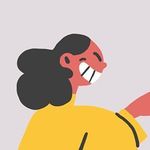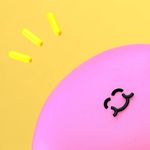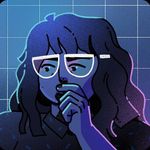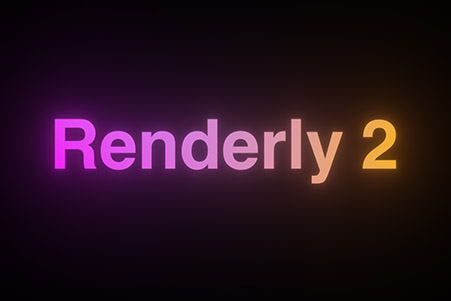When I was first starting out as a freelance motion designer, I wanted more than anything to be better, impatiently so really. I had all these ideas in my imagination but when it came time to put my ideas on the screen there was a disconnect, my work wasn’t living up to what I had in my head.
Around the same time, I remember seeing this kinetic type video of an Ira Glass interview that summed up the feeling I had perfectly:
It’s still wonderful advice, and if any motion designer ever asks me how to improve it’s one of the first recommendations I give: do a whole lot of work, it’s that process of creating where the real learning happens.
Watching the video again recently got me thinking about other ways motion designers can improve - so I decided to ask the experts! I reached out to some of the best motion designers out there right now making wonderfully creative work, and I asked them one question:
What’s the best way to improve as a motion designer?
I was thrilled with the responses I received, here’s what they had to say:

Rosie Phillpot
In my opinion, to keep improving as a motion designer, it is essential to keep pushing yourself outside of your comfort zone. I have found that animating other people's work is an excellent way of doing this. When you animate your own designs, it's always tempting to create illustrations in a style you have animated 100s of times before! It can be a refreshing challenge to take someone else's design or storyboard and solve how to best animate it.
Another thing that has helped me improve a lot over the years is to watch live streams of other creatives working. I often don't take in all of the information when watching a tutorial, because I am focusing on copying what is being done simultaneously in my After Effects project. With a stream, I can watch it and soak it in, without the distraction of trying to replicate what they're doing. The Adobe Live streams are great!
And finally, studying other people's work! I will often watch back parts of animations I love, frame by frame, to get an insight into how it has been created. It's important not to copy, but it can give you little tips and tricks to apply to your own work.

Dan Woodger
A few things, first is just boring old practice. The more you work at it the better you get. You'll make tonnes of stuff that looks terrible or doesn't quite work or isn't 'sharable' on social media, but that's ok, it's the skills you learn though that process that eventually help you to make the good stuff.
Secondly, I love comedic pacing, so I study old cartoons like Looney Tunes and download certain sequences I like as gifs. Then I open them in photoshop so I can break down the movement frame by frame so I better understand how they were crafted. This helps so much when I approach the movement of my own characters.

Emonee LaRussa
To me the best way to improve as a motion designer (and honestly any other craft or hobby) is [practise] at least an hour a day.
Whether it's in the program, researching techniques, watching tutorials, or looking at other amazing artists in that field. Jimi Hendrix carried his guitar on him at all times. Greatness comes with time :)

Alfie Bogush
The best way to improve as a Motion Designer is to work with other Motion Designers. I've always stood by this throughout my career so far.
The most valuable thing you can do is try and get a job (even as an apprentice, intern, runner or junior) where you'll be working in a team of already established Motion Designers.
This coupled with the fact you work on real client projects in a team, will allow you to build essential experience that helps you gain fundamental knowledge on the entire scope of everything Motion Design.

Lana Simanenkova
It all comes down to mindful practice. What I mean by that is creating work that focuses on improving certain aspects. Like if you are bad at drawing backgrounds, start incorporating background elements in your work etc. It's not something you'd see a result on straight away but it's the most surefire way I found myself improving.
Also cataloguing your works in a blog or something helps to see that journey you take to improving. Comparing a piece of work from a year ago to today would usually give me the motivation to not stop experimenting and trying out new things in my work.

Mat Voyce
Keep practising, I know, I know it sounds typical but PRACTISE MAKES PERFECT. The more you practise the quicker you get, the quicker you get the more you can learn about your workflow and personal style.
Also get yourself enrolled on to one of the many online courses out there, like the Motion Design School - Fundamentals, it will kick start your motion knowledge using an industry standard program that has endless possibilities.

Marta Azaña
The best way to improve as a motion designer is the continued experimentation and sometimes that requires stepping out of your comfort zone. Set yourself new challenges and do personal work often enough, always remembering that the main goal should be to enjoy and learn.
Set realistic goals. Make sure to find inspiration everywhere, not just from other animators, but from any type of artist or even day to day situations or objects.

Andrew Embury
- Study the fundamentals of motion.
- Learn the 12 principles of animation by the 9 old men of Disney.
- Keep practicing.
Andrew also shared some wonderful presentations created for the Keyframes conference in 2019. Speaking on the topic of career progression as a motion designer Andrew explains that there is no one course that makes you a better motion designer, but in fact the power is in team work, practice, and perhaps most importantly in enjoying the process.
Andrew also includes some wonderful quotes from other creatives, directors, and actors on the topic, my favourites include:
Whenever someone creates something with all their heart then that creation is given a soul.
~Hayao Miyazaki
Animation is about creating the illusion of life. And you can't create it if you don't have one.
~Brad Bird
To be an artist, you don't have to compose music or paint or be in the movies or write books. It's just a way of living. It has to do with paying attention, remembering, filtering what you see and answering back, participating in life.
~Viggo Mortensen

Sigrún Hreins
The best way to improve in my opinion, is to keep challenging yourself to learn new things constantly. Take online animation/design courses and watch a lot of tutorials on Vimeo, Skillshare and Youtube. Keep pushing yourself out of your comfort zone. Try different styles of animating/designing.
It's also good to follow fellow motion designers on Vimeo, Dribbble and Instagram who are doing awesome work and get inspiration from them.

James Horton
Working with your program of choice everyday is by far the easiest way to improve as a designer. The first 2 years I started working as a full time motion designer was definitely when I learnt the most in my entire career, basically just because I was just working with after effects five days a week. Obviously it's not something everyone can do but if you get that opportunity I highly recommend you take it if you're still looking to improve.
You don't even have to worry about creating something everyday though, just working on the program everyday is enough!

Erica Anderson
I think the best way for someone to improve as a motion designer would be to pick up traditional animation skills. Animation at its core is about movement and timing, and I can't think of a better way to illustrate that than to actually drawing each frame yourself. Having that foundation of learning about form, the weight of an object, and how it would actually move in a physical space made me a better animator.
Also looking up reference footage, and breaking down the how and the why something moves the way that it moves is crucial. Every breath we take, every blink, how we walk, how we run, etc, it's all a pattern. I don't think you can understand that rhythm of life without observing it first.

Nick Greenawalt
The best way to improve as a motion designer is try something new on every project. You are doing creative work, so take some creative chances! Sometimes it's not glamorous and the clients are shitty, but at the end of the day, you are getting paid to make art. It's the coolest fucking thing ever.
Don't be afraid of failure. Every failure is a valuable lesson. Take chances and experiment. You won't become an expert overnight.

Eva Münnich
Find people that encourage and push you
Before I moved to London in 2017 I lived in a small town in Germany. Jobs there were fine but not very challenging. So my skills plateaued quickly and I got very frustrated. Moving to London and getting to know all the lovely animation people here gave me a huge push. I felt like “damn, I'm running with the cool kids now - better crank up my stuff“. Groups like She drew that and Panimation have been a great way to meet other freelancing women and get the encouragement to follow my own vision.
Work hard and invest in your strengths
Working in motion design feels like you need to know everything in every program there is. That's simply not possible. Find which technique suits your ideas best and invest in that. Never stop learning and use platforms like school of motion or Domestika to push through your skill plateau.
Take yourself and your ideas seriously
Your weirdness is unique. Your artistic voice is unique. Take that seriously and never downplay that! Whatever it is that's going on in your head embrace it and make it! There's so much boring shit out there. If your stuff is authentic people will appreciate and celebrate it.
Doing my own thing was a very conscious decision for me. People always say "Just do what you want" - but to find out what that actually is - that's the hard part!

Dwayne Sealey
Do any and all tutorials that pique your interest.
You never know when the skills you learned in a tutorial you randomly did for fun will be perfect for a client/personal project. Doing tutorials can actually be a good starting point for personal projects which leads to my next tip.
Work on and FINISH personal projects.
Making personal work on a consistent basis is something I still struggle with, but most of the work that has resulted in the most growth has been self-initiated. This seems to be true for most people.
On second thought, don't think of them as "personal projects", think of them as experiments or creative exploration.
Take the pressure off, these are supposed to fun after all! Try to approach them with no expectations for how it will turn out or be received by other people. Just get in the habit of creating for yourself on a consistent basis.
It'll help to develop your artistic voice and will make you stand out as a motion designer.
Cultivate interests and hobbies outside of motion design/animation.
This will not only help you become a more well-rounded motion designer but a more well-rounded person in general. You'll have more knowledge, experience, and references to draw from when working on projects.
Take care of your health and prioritize sleep.
No project is worth jeopardizing your health for. Being well-rested will help you think more clearly which is crucial when you're a creative professional.
And finally,
Invest in the best hardware you can afford, and read 'The Animator's Survival Kit' by Richard Williams.

Yino Huan
Look for/at references and practise. :)
This might be skewed towards hand drawn animation, but my biggest error for a long time was to think that my imagination could just spit out perfect physicalities, anatomies, ideas etc. without ever studying how things work and what they look like. It obviously couldn't.

Alyssa Smedley aka: Horrible Horris
My biggest tip is to just keep making stuff. Small, quick projects where you can be more experimental without too much pressure. Initiatives like Monday's Challenge are perfecto for this if you need that springboard for ideas and the motivation in a short deadline.
Alyssa also has an awesome page on wisdom sharing which you should definitely check out!

Camille Vincent
When it comes to skill level, personal and creative work will get you far. Client work improves speed, communication, and preparedness. Always go into projects looking to learn something if you can.

Desmond Du
The best way to improve as a Motion Designer is your way...
...The real question to ask is what kind of Motion Designer do you want to become? How do you position yourself to differentiate yourself from others? One that specializes in After Effects expression/scripting? Or someone who makes beautiful Cinema 4D Octane renders? Or are you known for a certain type of aesthetic or style? I wrote a brief guide on how I positioned myself for success in my Medium article, do check it out for my in-depth thoughts.
Everything begins with your intentions. The strategy is to niche down to your strengths and interests, and manifest those two things into your career or work. Take a look at Ordinary Folk, Vucko, Peter Clark, GMunk, or any other successful artists. Think about what makes them outstanding, and how you can incorporate that into your career. One introspective framework to use the Japanese concept of "Ikigai" which translates to "a reason for being."
To break it down simply, it is a compass of your soul that will bring you to where you need and want to be. A strong ikigai lasts a lifetime, and you will never be lost because you know where you are walking. Once you identify what sort of designer or animator you want to become, start creating works that echo that identity. Personally, I positioned myself as an educator; someone who loves to teach and wants to develop a teaching career in the future. I demonstrate that through my YouTube tutorials and doing software workshops for students in school, it is as simple as that.
As for a surefire way to get better at motion design skills (eg. design, animating, expressions), I realized that teaching is the best and fastest way. As the Physicist Richard Feynman said: "If you want to master something, teach it."
Teaching is a way to translate the external knowledge you gained into something of your own. It crystallizes competency and expertise, allowing you to challenge what you think you know. Many of you reading this now will think to yourself: "But I'm not good enough" or "I'm not a master so I cannot teach".
Personally, I believe that mastery is an act or behaviour, not a role or label. You do not need to be a famed motion designer like Ben Mariott or JR Canest to teach. You demonstrate mastery by teaching even if you are just teaching a beginner how to use the pen tool in After Effects. Whether you do that via Instagram carousel posts, YouTube tutorials, or blogging, it is up to you. Find out what works best for you.

Giulia Martinelli
This is my advice, in a nutshell, if I could talk to my younger self or if I had to give some tips to someone starting out:
- Do not try to chase trends and do not give too much value to the social-media instant reward. Invest in personal exploration and have fun with it!
- Give space and time for personal projects and find ways to experiment and be creative also while doing client work.
- Surround yourself with talented peers to learn from each other and get feedback about your work
Some great advice I’m sure you’ll agree, a big thank you to the motion designers who responded to my request.
My own advice beyond doing a lot of work, would be to learn the basics of design, not just the fundamentals of animation but also more traditional design too. Learn about grids, typography, colour - knowing the rules, what works and what doesn’t, will give you the confidence to create great work.
Ultimately, I think one thing that’s clear from the list above is that there’s no one way to get better as a motion designer, there’s all sorts of things you can do to improve. Perhaps, as Desmond says in his response: “The best way to improve is your way” so take some time and assess what you like doing, and who knows maybe you’ll be up there with the best motion designers one day!
Have a response you’d like to share on how motion designers can improve? Send it in an email to [email protected]

